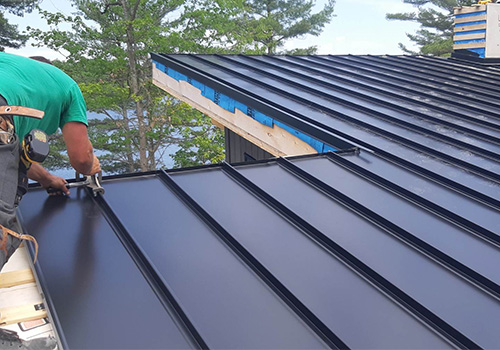When it comes to choosing a metal roof, there are many factors to consider. The following are just a few of them: Durability, cost, and appearance. Fire resistance is another consideration. In addition, you should know about panel profiles, which are the way two panels are joined. The type of panel profile you choose will determine how the panels are installed.
Metal roofing is a durable option for a sustainable roofing system. It is estimated that metal roofs can last for 50 to 75 years, making them an excellent choice for a new or existing home. Additionally, metal roofing is more resilient to wind damage than traditional roofing and can withstand wind speeds of up to 140 mph. These properties make metal an excellent choice for areas where strong storms are common. Metal roofing can also withstand heavy snow and ice.
Another advantage of metal roofing is its fire resistance. It has the highest fire rating of any roofing material. It also protects against harsh UV rays. A metal roof is also resistant to hail. Having a metal roof installed on your home will protect your house during a hurricane or a fire. This durability is often recognized by insurance companies, which often offer discounts for installing metal roofs. Solar panels can also be installed on metal roofing for increased energy efficiency.
Unlike traditional asphalt shingles, metal roofs are extremely resistant to hail. A study found that metal roofs are significantly less likely to be damaged by hail. And hail can strike a roof at a distance of 140 miles an hour, which makes metal roofing a superior choice for storm-proofing.
Another advantage of metal roofing is that it does not split, crack, or rot. This means that your roof will last for decades without any maintenance. In fact, a metal roof will typically last 40 to 70 years, which is much longer than traditional asphalt shingles. This type of roofing also retains heat, seals out water, and is aesthetically pleasing.
The cost of metal roofing can vary depending on the type and
design of the roof. It can also depend on the materials that are used for the roof. Metal roofing can be made from many materials, including corrugated metal panels, residential grade 26-to-24-gauge steel, aluminum, zinc, copper, stainless steel, and titanium. Regardless of the material used, metal roofing is generally one of the least expensive roofing options. However, the final cost will depend on the complexity of the installation.
The cost of metal roofing can vary by region and the experience of the roofer. It is advisable to compare quotes from several companies before making a final decision. Also, consider the difficulty of the installation, panel profile, and location of the roof. The more expensive the material and the installation, the more it will cost.
Metal roofs are made of durable material and can mimic the look of other roofing materials. They are also energy-efficient and require little maintenance. In addition, they last longer than other construction materials. Corrugated metals can be purchased from most lumber stores across the country. These corrugated sheets are attached using screws, nails, rubber washers, and metal fasteners.
Another factor that determines the cost of metal roofing is the labor involved in the installation. This process requires precision and experienced installers. Additionally, metal roofing requires specific tools and equipment for proper installation. Supply and demand can influence labor costs as well. A professional installation will ensure that the roof is installed correctly and has a long lifespan.
Another advantage of metal roofing is its ability to conduct electricity. This property has made it less prone to lightning strikes, but it is important to consider lightning protection when installing metal roofing. Lightning protection companies can install lightning protection systems to prevent lightning strikes on homes. These systems also reduce the risk of fire. Metal roofing is an excellent option for homes with low-sloped rooflines.



